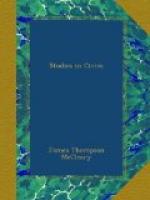Among the characteristics of those German ancestors of ours are the following: They were very independent; the free landholder was “the free-necked man.” The ties of kinship were very strong. “Each kinsman was his kinsman’s keeper, bound to protect him from wrong, to hinder him from wrong-doing, and to suffer with and pay for him if wrong were done.” [Footnote: Green’s History of the English People.] They were very much attached to home. “Land with the German race seems everywhere to have been the accompaniment of full freedom.... The landless man ceased for all practical purposes to be free, though he was no man’s slave.” [Footnote: Green’s History of the English People.] Among themselves they were quite social. Though tillers of the soil they lived, not isolated, but grouped together in small villages. This may have been partly for mutual protection. They were lovers of law and order.
The Township.[Footnote: See American Political Ideas, pp. 31-63.]—The derivation of the word “township” shows us to whom we are indebted for the institution itself. The word is derived from the Anglo-Saxon tun-scipe. Tun meant hedge, ditch or defense; and scipe, which we have also in landscape, meant what may be seen. Around the village before mentioned was the tun, and beyond were the fields and meadows and woodlands, the whole forming the tun scipe or township.
To administer justice and to take any other action for the common good, the freemen gathered in folk-moot around the moot hill or the sacred tree.
Though the proceedings of these assemblies differed in detail from those of our town meetings, both contain the great principle of local self government.
The County.[Footnote: See American Political Ideas, pp. 31-63.]—Although with us the state is divided into counties and the counties into towns, the order of formation was originally the other way. The towns are the oldest institutions in our system. Later, from uniting forces in war came a union of action among adjoining towns during peace. Thus grew up what was called the Hundred.
When in the fifth century the English invaded Britain, many of the chieftains or military leaders rose to kingship over small areas. On the completion of the conquest these kings struggled among themselves for leadership, until finally England became united into one kingdom, and the little kingdoms were reduced to shires ruled by earls. With the growth of the king’s power, that of the underkings or earls grew less. Then other shires were formed, and this institution became simply an administrative division. After the Norman conquest the French terms count and county came into use.
The earnest student will find both pleasure and profit in looking up the origin and history of the trial by jury, the criminal warrant, the writ of habeas corpus, bail, common law, the general rules of parliamentary practice, etc.




